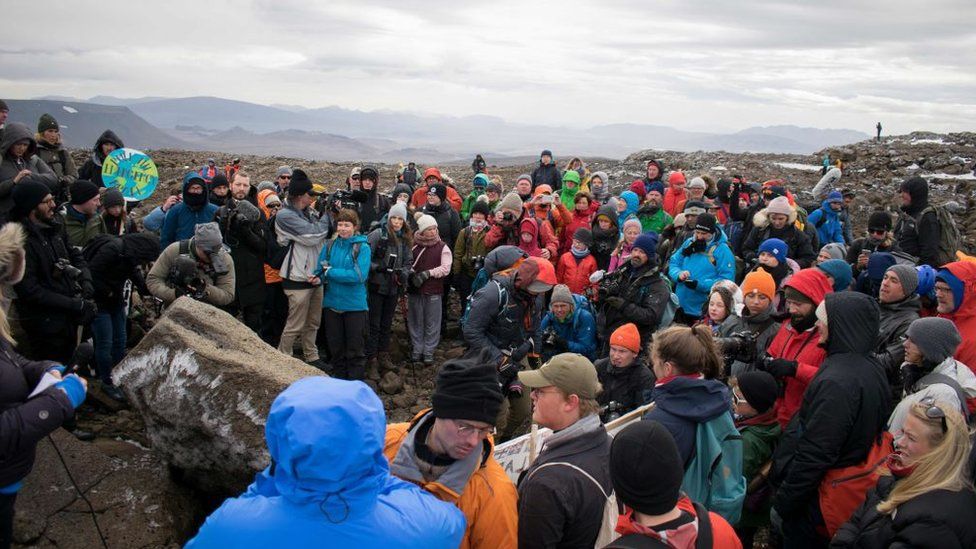Climate change: Iceland holds funeral for melted glacier
- Published
- comments

Iceland has marked the melting of a glacier by holding a mock funeral to say goodbye.
The glacier called Okjokull, is the first in the country to be lost to climate change, after the warmest July ever on record.
Iceland loses about 11 billion tonnes of ice per year, and scientists have warned that there are about 400 other glaciers also at risk.
They fear all of the island's glaciers will be gone by 2200. Glaciers cover about 11% of Iceland's surface.
The funeral was organised by local researchers and staff at Rice University in the United States. But they were far from the only ones in attendance.
The country's Prime Minister Katrin Jakobsdottir and former United Nations High Commissioner for Human Rights, Mary Robinson, were also there.
They were joined by hundreds of scientists, journalists and members of the public who trekked to the site.
What happened to the Okjokull glacier?
Glaciologists (scientists who study glaciers) stripped Okjokull of its glacier status in 2014, a first for Iceland.
In 1890, the glacier ice covered 16 square kilometres (6.2 square miles) but by 2012, it measured just 0.7 square kilometres, according to a report from the University of Iceland from 2017.
To have the status of a glacier, the mass of ice and snow must be thick enough to move by its own weight. For that to happen the mass must be approximately 40 to 50 metres (130 to 165 feet) thick, he said.
Organisers even put a bronze plaque on a rock at the site as part of the a ceremony to remember the former glacier.
It is "the first monument to a glacier lost to climate change anywhere in the world", Cymene Howe, associate professor of anthropology at Rice University, said in July.
She added: "By memorialising a fallen glacier, we want to emphasise what is being lost - or dying - the world over, and also draw attention to the fact that this is something that humans have 'accomplished', although it is not something we should be proud of."
The plaque reads "A letter to the future" and is intended to raise awareness about the decline of glaciers and the effects of climate change.
It continues: "In the next 200 years all our glaciers are expected to follow the same path. This monument is to acknowledge that we know what is happening and what needs to be done. Only you know if we did it."
It is also labelled "415 ppm CO2", referring to the record level of carbon dioxide measured in the atmosphere last May.
Julien Weiss, an aerodynamics professor at the University of Berlin, went to the ceremony with his wife and seven-year-old daughter.
"Seeing a glacier disappear is something you can feel, you can understand it and it's pretty visual," he said.
"You don't feel climate change daily, it's something that happens very slowly on a human scale, but very quickly on a geological scale."
Prime Minister Jakobsdottir warned that, because a large part of Iceland's renewable energy is produced in the glacial rivers, the disappearance of the glaciers will affect the country's energy system.
He said: "I hope this ceremony will be an inspiration not only to us here in Iceland but also for the rest of the world, because what we are seeing here is just one face of the climate crisis."
According to a study published by the International Union for Conservation of Nature (IUCN) in April, nearly half of the world's heritage sites could lose their glaciers by 2100 if greenhouse gas emissions continue at the current rate.
- Published19 August 2019
- Published21 May 2019
- Published8 October 2018
